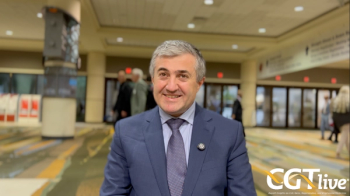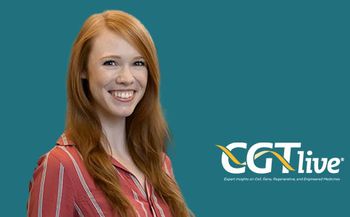
Continuing Challenges in Treating Indolent B-Cell Lymphoma
Christopher R. Flowers, MD, reviewed challenges of treating indolent B-cell lymphoma.
This content originally appeared on our sister site,
Patients with follicular lymphoma (FL) and other forms of indolent non-Hodgkin lymphoma (iNHL) worldwide live disease-free for a decade or longer following first-line therapy, suggesting that it may be possible to develop a cure for at least a subset of patients. However, 1 of the most common causes of death for patients with these diseases, which are commonly considered incurable with continual risk of relapse over time, shorter durations of response with each subsequent line of therapy, and a risk of transformation to a more aggressive
Indolent B-cell lymphomas were explored in a session during the Society of Hematologic Oncology 2021 Annual Meeting by Jessica Okosun, MA, MB BChir, MRCP, FRCPath, PhD, Peter Martin, MD, Loretta Nastoupil, MD, and Caron Jacobson, MD, MMS in 4 presentations: “Molecular Pathogenesis of Follicular Lymphoma and Its Relevance to Clinical Practice,” “Sequencing Therapy in Follicular Lymphoma,” “Novel Therapies in Indolent Lymphoma,” and “CAR T-Cell Therapy in Indolent Lymphoma” in lectures by world-class experts
Next-generation sequencing studies, led by Michael R. Green, PhD, Dr Okosun, and others, have described the panoply of genomic events involved in FL and have aided in identifying candidate genetic drivers.6-9 This work clarified the diverse genomic landscape and the temporal clonal dynamics of FL. Common genomic events that occur with t(14;18) include high frequencies of mutations affecting epigenetic regulation, disruptions in pathways such as those involved in immune recognition (eg, TNFRSF14), NF-KB (eg, CARD11), and JAK/STAT signaling (eg, STAT6).9,10 Next-generation sequencing also has been used to examine factors associated with progression of FL, transformation of iNHL to more aggressive lymphomas, and spatial heterogeneity in FL. Recent studies have explored the subclonal diversity and spatial heterogeneity observed among patients with FL that have potential clinical implications for the development of prognostic and predictive biomarkers and targeted treatment strategies. For instance, exome sequencing of FL tumors and paired germline have identified nonsynonymous somatic variants corresponding to missense (81%), indels (10%), nonsense (7%), and splice site (2%) changes.6
READ MORE:
This work revealed spatially discordant mutations in genes such as EZH2 and EP300. One attractive treatment paradigm emerging from this work involves specifically targeting highly recurrent and truncal gene mutations that have roles in FL pathogenesis. Other studies did not identify a single compelling genetic event responsible for transformation, but instead suggest that the acquisition of certain genetic alterations may result in aggressive transformation.7,9,11 Exploration of the FL genomics in this session can clarify stratified treatment approaches targeting specific early genetic lesions identified in FL and may eventually provide strategies to eradicate these cell populations and provide pathways to cure FL.
In the past decade, many new agents have been introduced for the management of FL, and therapeutic strategies have evolved over time. Recently, my co-chair in this session, Nathan Fowler, MD, and I reviewed data from trials addressing the safety and efficacy of lenalidomide alone and in combination with rituximab as a first-line therapy and as a treatment of patients with relapsed/refractory FL.12 However, since that review other agents have received FDA approval for patients with relapsed FL. There is considerable variation in response rates for recently approved therapies ranging from objective response rates of 40% to 60% for PI3K inhibitors, 35% to 65% for EZH2 inhibitors, and greater than 70% for autologous stem cell transplantation, and CD19-directed chimeric antigen receptor (CAR) T-cell therapy.13-18 Recently approved therapies in relapsed FL have commonly been based on response rate and duration of response (DOR) demonstrated in phase 2 studies. However, despite numerous trials performed in the field, there is no single standard of care for patients with iNHL who are undergoing second-line treatment or beyond.
As a result of the patterns of relapse and transformation associated with iNHL, the clinical treatment of patients with FL and other iNHLs often requires multiple lines of therapy using various regimens with different mechanisms of action.19-22 The clinical benefits and adverse effects associated with the treatments available at relapse vary and are influenced by patient and disease characteristics at the time of progression, the duration of the interval from last treatment, and the toxicity and responses associated with the treatments previously administered. This results in a marked heterogeneity of clinical situations encountered during the treatment of these patients. Some patients with iNHL will remain well treated using available treatments, whereas others will develop disease refractory to conventional approaches and become candidates for novel treatments and clinical trials. Additional real-world data regarding patient characteristics at relapse, patterns of care, expectations of response rates and duration, and survival outcomes are lacking in the setting of relapsed and refractory iNHL. To help inform treatment decisions by health care providers treating patients with iNHL in this complex and evolving treatment landscape, Dr Martin will describe approaches for sequencing therapies. To optimally individualize treatment strategies for patients with previously untreated and relapsed iNHL, the risks and benefits of the available options should be well known. This lecture will enable providers to effectively discuss the goals of therapy with the patient at each intervention, which is also critical in providing an optimal sequence of therapy.
Although many patients with FL experience long or possibly near-normal life expectancies, there remains persistent variability in patient outcomes.19-22 Patients who relapse within 2 years of first-line chemoimmunotherapy or with histologic transformation are at risk for early mortality and are high-priority candidates for novel treatment strategies evaluated in clinical trials.23-25 Prior studies have demonstrated diminishing DOR by line of therapy.26,27
However, variability of iNHL disease biology, treatment options, and treatment patterns complicate outcome assessments based on line of therapy alone. Several novel and targeted therapies are being developed and evaluated in patients with relapsed iNHL, including cereblon inhibitors, anti–CD20-CD3 bispecific antibodies, and additional anti-CD19 CAR T-cell therapies. Dr Nastoupil will provide key insights on the novel therapies available for patients in clinical trials and those that are establishing pathways toward applications in clinical settings.
CAR therapy targeting CD19 is one promising treatment for patients with relapsed or refractory FL and CD19+ iNHLs. Patients who are candidates for CAR T-cell therapy often have symptomatic disease that could be fatal if left untreated. Dr Jacobson will discuss strategies for bridging therapy, which may include chemotherapy, targeted therapy, or radiation therapy; approved and experimental CAR T-cell approaches for FL and iNHLs; and describe traditional and novel adverse events and outcomes from clinical trials involving CAR T-cell therapy.
REFERENCES
1. Sarkozy C, Maurer MJ, Link BK, et al. Cause of death in follicular lymphoma in the first decade of the rituximab era: a pooled analysis of French and US cohorts. J Clin Oncol. 2019;37(2):144-152. doi:10.1200/JCO.18.00400
2. Bachy E, Seymour JF, Feugier P, et al. Sustained progression-free survival benefit of rituximab maintenance in patients with follicular lymphoma: long-term results of the PRIMA study. J Clin Oncol. 2019;37(31):2815-2824. doi:10.1200/JCO.19.01073.
3. Becnel MR, Nastoupil LJ, Samaniego F, et al. Lenalidomide plus rituximab (R 2 ) in previously untreated marginal zone lymphoma: subgroup analysis and long-term follow-up of an open-label phase 2 trial. Br J Haematol. 2019;185(5):874-882. doi:10.1111/bjh.15843
4. Strati P, Jain P, Johnson RJ, et al. Long-term follow-up of lenalidomide and rituximab as initial treatment of follicular lymphoma. Blood. 2021;137(8):1124-1129. doi:10.1182/blood.2020007994
5. Watanabe T, Tobinai K, Wakabayashi M, et al; JCOG0203 Collaborators. Outcomes after R-CHOP in patients with newly diagnosed advanced follicular lymphoma: a 10-year follow-up analysis of the JCOG0203 trial. Lancet Haematol. 2018;5(11):e520-e531. doi:10.1016/S2352-3026(18)30155-8
6. Araf S, Wang J, Korfi K, et al. Genomic profiling reveals spatial intra-tumor heterogeneity in follicular lymphoma [published correction appears in Leukemia. 2019;33(6):1540]. Leukemia. 2018;32(5):1261-1265. doi:10.1038/s41375-018-0043-y
7. Green MR, Gentles AJ, Nair RV, et al. Hierarchy in somatic mutations arising during genomic evolution and progression of follicular lymphoma. Blood. 2013;121(9):1604-1611. doi:10.1182/blood-2012-09-457283
8. Green MR, Kihira S, Liu CL, et al. Mutations in early follicular lymphoma progenitors are associated with suppressed antigen presentation. Proc Natl Acad Sci U S A. 2015;112(10):E1116-E1125. doi:10.1073/pnas.1501199112
9. Okosun J, Bödör C, Wang J, et al. Integrated genomic analysis identifies recurrent mutations and evolution patterns driving the initiation and progression of follicular lymphoma. Nat Genet. 2014;46(2):176-181. doi:10.1038/ng.2856
10. Kumar E, Pickard L, Okosun J. Pathogenesis of follicular lymphoma: genetics to the microenvironment to clinical translation. Br J Haematol. Published online March 10, 2021. doi:10.1111/bjh.17383
11. Okosun J, Montoto S, Fitzgibbon J. The routes for transformation of follicular lymphoma. Curr Opin Hematol. 2016;23(4):385-391. doi:10.1097/MOH.0000000000000255
12. Flowers CR, Leonard JP, Fowler NH. Lenalidomide in follicular lymphoma. Blood. 2020;135(24):2133-2136. doi:10.1182/blood.2019001751
13. Dreyling M, Santoro A, Mollica L, et al. Phosphatidylinositol 3-kinase inhibition by copanlisib in relapsed or refractory indolent lymphoma. J Clin Oncol. 2017;35(35):3898-3905. doi:10.1200/JCO.2017.75.4648
14. Flinn IW, Miller CB, Ardeshna KM, et al. DYNAMO: a phase II study of duvelisib (IPI-145) in patients with refractory indolent non-Hodgkin lymphoma. J Clin Oncol. 2019;37(11):912-922. doi:10.1200/JCO.18.00915
15. Gopal AK, Kahl BS, de Vos S, et al. PI3Kδ inhibition by idelalisib in patients with relapsed indolent lymphoma. N Engl J Med. 2014;370(11):1008-1018. doi:10.1056/NEJMoa1314583
16. Jacobson C, Chavez JC, Sehgal AR, et al. Primary analysis of zuma-5: a phase 2 study of axicabtagene ciloleucel (axi-cel) in patients with relapsed/refractory (r/r) indolent non-Hodgkin lymphoma (iNHL). Blood. 2020;136(suppl 1):40-41. doi:10.1182/blood-2020-136834
17. Metzner B, Pott C, Müller TH, et al. Long-term clinical and molecular remissions in patients with follicular lymphoma following high-dose therapy and autologous stem cell transplantation. Ann Oncol. 2013;24(6):1609-1615. doi:10.1093/annonc/mds657
18. Morschhauser F, Tilly H, Chaidos A, et al. Tazemetostat for patients with relapsed or refractory follicular lymphoma: an open-label, single-arm, multicentre, phase 2 trial. Lancet Oncol. 2020;21(11):1433-1442. doi:10.1016/S1470-2045(20)30441-1
19. Flowers CR, Leonard JP, Nastoupil LJ. Novel immunotherapy approaches to follicular lymphoma. Hematology Am Soc Hematol Educ Program. 2018;2018(1):194-199. doi:10.1182/asheducation-2018.1.194
20. Leonard JP, Nastoupil LJ, Flowers CR. Where to start? Upfront therapy for follicular lymphoma in 2018. Hematology Am Soc Hematol Educ Program. 2018;2018(1):185-188. doi:10.1182/asheducation-2018.1.185
21. Nastoupil LJ, Flowers CR, Leonard JP. Sequencing of therapies in relapsed follicular lymphoma. Hematology Am Soc Hematol Educ Program. 2018;2018(1):189-193. doi:10.1182/asheducation-2018.1.189
22. Salles G. How do I sequence therapy for follicular lymphoma? Hematology Am Soc Hematol Educ Program. 2020;2020(1):287-294. doi:10.1182/hematology.2020000156
23. Casulo C, Byrtek M, Dawson KL, et al. Early relapse of follicular lymphoma after rituximab plus cyclophosphamide, doxorubicin, vincristine, and prednisone defines patients at high risk for death: an analysis from the National LymphoCare Study. J Clin Oncol. 2015;33(23):2516-2522. doi:10.1200/JCO.2014.59.7534
24. Casulo C, Friedberg JW, Ahn KW, et al. Autologous transplantation in follicular lymphoma with early therapy failure: a National LymphoCare Study and Center for International Blood and Marrow Transplant Research analysis. Biol Blood Marrow Transplant. 2018;24(6):1163-1171. doi:10.1016/j.bbmt.2017.12.771
25. Casulo C, Nastoupil L, Fowler NH, Friedberg JW, Flowers CR. Unmet needs in the first-line treatment of follicular lymphoma. Ann Oncol. 2017;28(9):2094-2106. doi:10.1093/annonc/mdx189
26. Batlevi CL, Sha F, Alperovich A, et al. Follicular lymphoma in the modern era: survival, treatment outcomes, and identification of high-risk subgroups. Blood Cancer J. 2020;10(7):74. doi:10.1038/s41408-020-00340-z
27. Link BK, Day BM, Zhou X, et al. Second-line and subsequent therapy and outcomes for follicular lymphoma in the United States: data from the observational National LymphoCare Study. Br J Haematol. 2019;184(4):660-663. doi:10.1111/bjh.15149
Newsletter
Stay at the forefront of cutting-edge science with CGT—your direct line to expert insights, breakthrough data, and real-time coverage of the latest advancements in cell and gene therapy.

















































